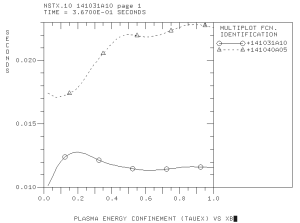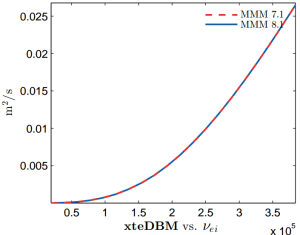Summary of plasma collisionality studies
- The MMM8.1 model in TRANSP reproduces the experimental dependence of the energy confinement times on the plasma collisionality. However, the values of the predicted confinement times are systematically larger than the confinement times derived from experiments. Most likely reason is missing transport from modes that are not part of MMM8.1 such as microtearing modes.
- Plasma collisionality scan using standalone MMM8.1 model revealed that most components in MMM8.1 can not explain the
dependence that is observed in predicted TRANSP simulations and in experiment. The Weiland component that computes fluxes associated with most drift-wave instabilities such as ITG modes in the plasma core shows that the electron and ion thermal diffusivities are stabilized by the plasma collisionality. This effect is expected because of known dumping effect of plasma collisionality on the drift-wave modes. There are two possible explanations of the discrepancies between predictive and standalone MMM8.1 runs.
- In experimental plasma collisionality scans, it is very difficult to keep all dimensionless parameters unchanged. In particular, it is difficult to maintain the plasma current distribution unchanged when the plasma density changes. As result, there are notable differences in the safety factor profiles between two discharges. When the q and magnetic shear from one discharge is used in standalone runs for the other discharge, the expected
dependence is partially recovered. The differences between safety factor and magnetic shear profiles can not completely explain the differences in the
dependencies in the predictive and standalone runs, but these differences in the experimental profiles make contribution in the right direction.
- There are modes in that DRIBM model in MMM8.1 that becomes more unstable with the resistivity. These modes are difficult to separate from other MHD modes that are described by DRIBM. However, our previous studies for DIII-D clearly show the expected
dependence:
The resistive mode in DRIBM that is found to be destabilized with the plasma collisionality is typically has large contribution in the plasma edge region near the separatrix. Note that the paleoclassical model that is distributed together with the MMM8.1 model is expected to have a similar dependence on the resistivity. However, the paleoclasical model is still being validated. Usually, it is not used in the predictive runs with the MMM8.1 model.
- In experimental plasma collisionality scans, it is very difficult to keep all dimensionless parameters unchanged. In particular, it is difficult to maintain the plasma current distribution unchanged when the plasma density changes. As result, there are notable differences in the safety factor profiles between two discharges. When the q and magnetic shear from one discharge is used in standalone runs for the other discharge, the expected




Leave a Reply